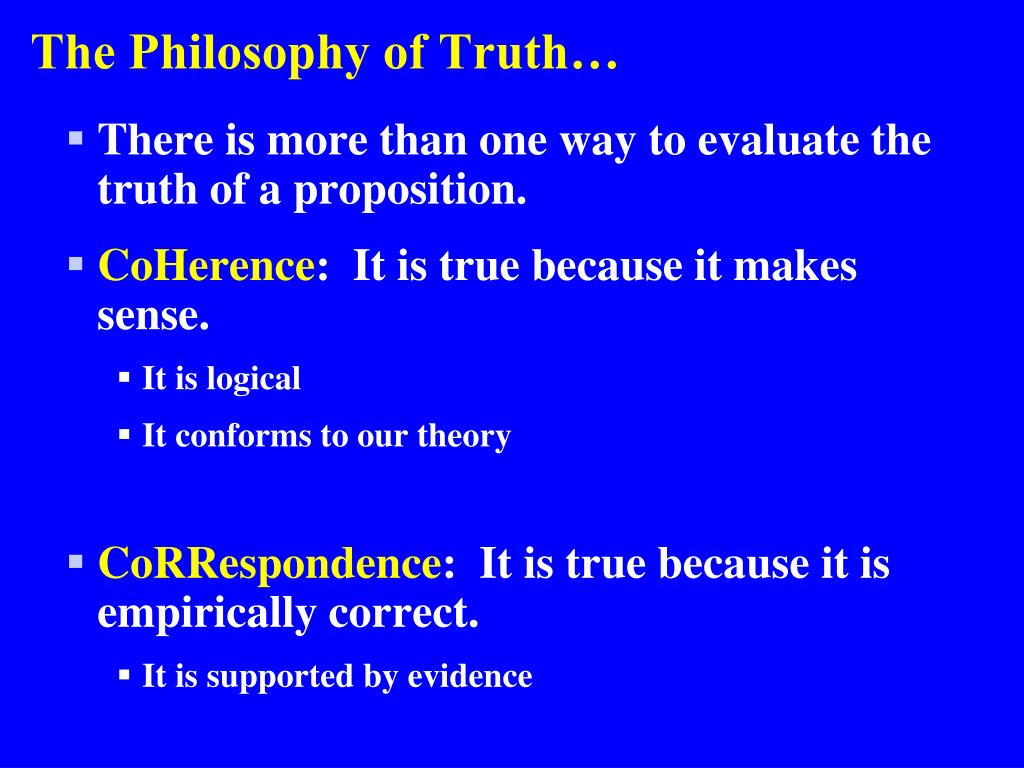

Since coherence is seen as that which foundationally confers validity to any truth claims, it necessarily fails to find validation itself as that which can confer validity validly. In my view as well as Winfield’s, this makes the coherence theory of truth just one more kind of foundational epistemology. The coherence theory of truth, then, either can’t be legitimately validated or must give up the universality of its truth-granting. Naturally, if the latter alternative were the case, this would contradict the coherence theory of truth’s constitutive claim that all knowledge lies in coherence.” Winfield, Reason and Justice, p. “Since that would involve employing as the basis of the demonstration precisely what must be proved, the principle of the coherence theory of truth is caught in the unenviable predicament of either lacking justification or being based on knowledge obtained through other means. The first reflexive inconsistency is that one would be begging the question if the coherence theory of truth was itself shown to be true through coherence. Here, I’ll explain the self-referential incoherences of coherence theory brought up by Winfield and why systematic philosophy avoids these same problems. Nonetheless, the dismissal of Hegelian thinking in contemporary philosophy has in part been the result of a merely abstract disagreement with the coherence theory. Whether the British idealists or those early analytics who responded to them are to blame, I don’t know. The reason he did this, I can imagine, must have been because Hegelian systematic philosophy is constantly mistaken as a coherence theory. Moreover, there are accounts of negative facts, which serve as correspondents for negative truths.In a chapter on Hegel’s systematic logic, Richard Dien Winfield wrote a section on the coherence theory of truth, a theory which confers truth to a concept or belief by virtue of its coherence with others in a system of such concepts or beliefs. For example, there are structural accounts of correspondence designed to remove the metaphysical and epistemological mysteries. Yet, it is unclear how a true proposition about what is not real could correspond to something that is real.Ī common response to the challenges involves developing theories of the components involved. The worry here is that you cannot know whether any proposition is true if truth requires correspondence.Īnother challenge arises from alleged counterexamples. On the epistemology side, there is the worry that you could never know whether a proposition corresponds with things beyond your head, since you can’t get outside your head to see things as they are. So what is correspondence? Some philosophers worry that by analysing truth as correspondence you exchange the mystery of truth for a greater mystery. Correspondence is not analysable in terms of familiar physical relations, like distance or force. On the metaphysical side, there is the worry that a correspondence relation is intolerably mysterious. There are metaphysical and epistemological worries. Why? The correspondence theory predicts this correlation by analysing truth as a connection to reality.Ī principle challenge, on the other hand, is to understand the nature of the connection.

Therefore, a change in the cat correlates with a change in the proposition. If the cat gets off the mat, that proposition is not true. When the cat is on the mat, the proposition that the cat is on the mat is true. All versions of the correspondence theory arise from theories of these components.Ī principle advantage of a correspondence theory is that it accounts for the apparent correlation between the aspects of reality and the truth-value of a proposition. This difference between structural and correlation theories depends on one’s theories of three components: true things, real things described by the true things, and the correspondence between true things and real things. Other theories treat the connection as a nonstructural correlation between true things and the world. Some theories, for example, treat the connection as a structural relation that ties constituents of a true thing to constituents of the world. There are different ways to articulate the connection between true things and the reality they describe. In general, the truth of a proposition is sensitive to how real things are. Otherwise, that proposition fails to be true. For example, the proposition that a cat is on a mat is true if a real cat is on a real mat. To be true is to accurately describe – in other words, match, picture, depict, express, conform to, agree with or correspond to – the real world or parts of it. The correspondence theory in its simplest form says that truth is a connection to reality.


 0 kommentar(er)
0 kommentar(er)
